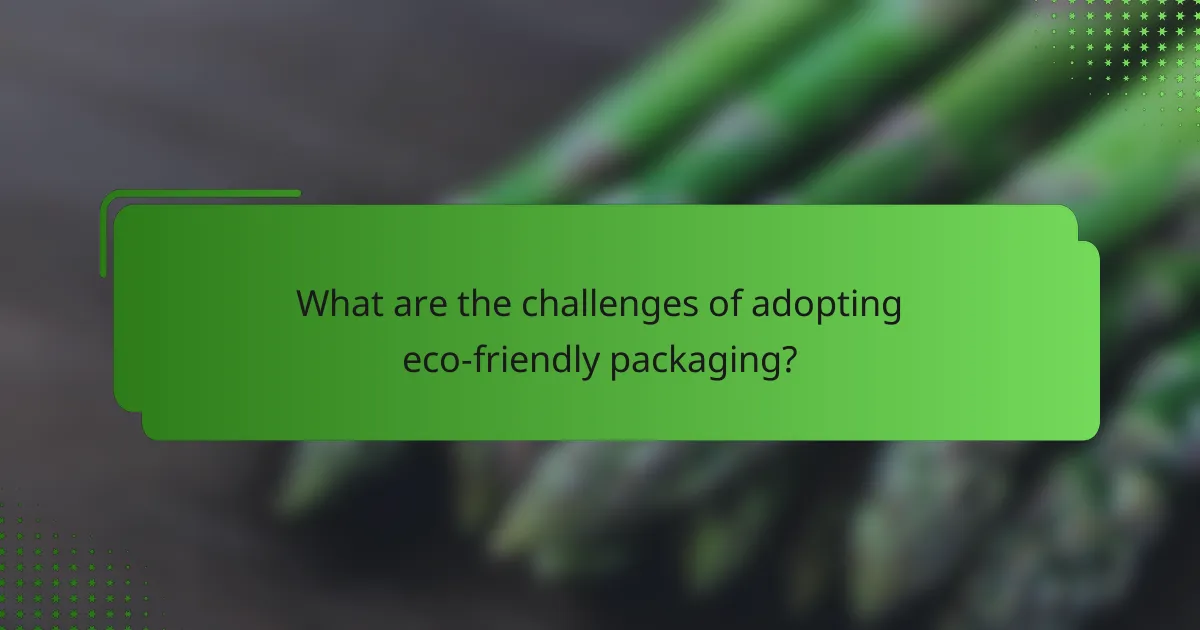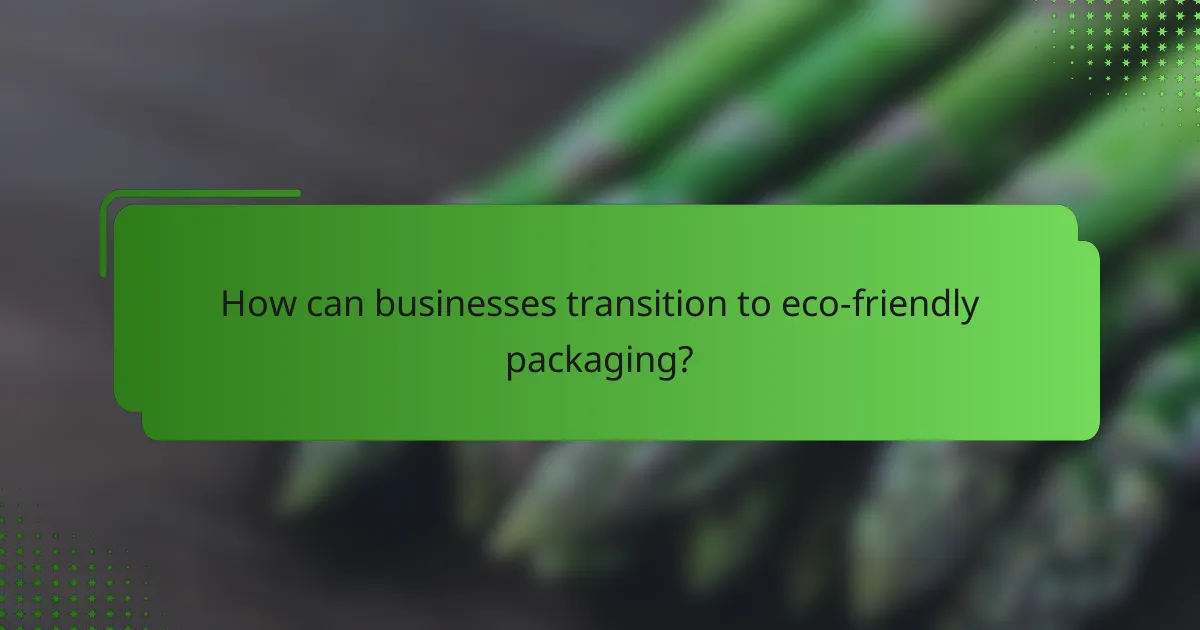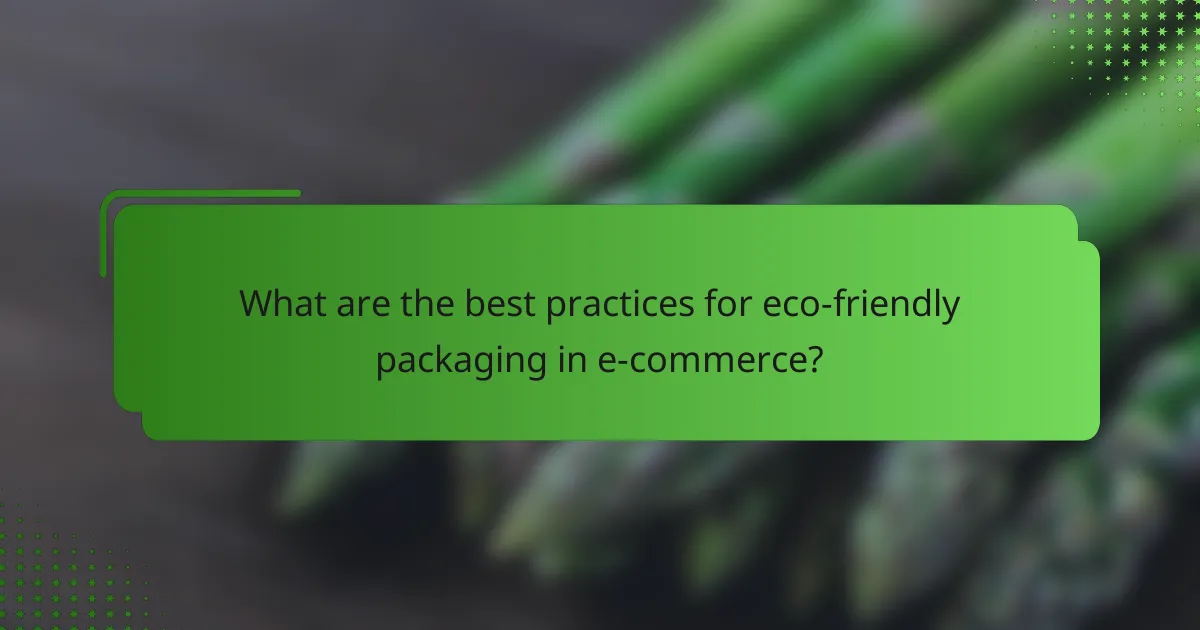Eco-friendly packaging is becoming increasingly important as consumers prioritize sustainability in their purchasing decisions. By utilizing materials such as recycled paper, biodegradable plastics, and compostable options, businesses can reduce their environmental impact while enhancing their brand reputation. As awareness of environmental issues grows, aligning packaging choices with consumer values not only meets regulatory requirements but also fosters a healthier planet.

What are the benefits of eco-friendly packaging?
Eco-friendly packaging offers numerous advantages, including reduced environmental impact, improved brand reputation, and potential cost savings. By choosing sustainable materials, businesses can align with consumer preferences and regulatory requirements while contributing to a healthier planet.
Reduced environmental impact
Eco-friendly packaging significantly lowers the carbon footprint associated with production and disposal. Materials like biodegradable plastics, recycled paper, and plant-based options break down more easily, reducing landfill waste and pollution. Companies can also minimize energy consumption by sourcing materials locally.
For example, using recycled cardboard instead of virgin materials can cut down on deforestation and energy use, making a tangible difference in environmental conservation efforts.
Enhanced brand reputation
Adopting eco-friendly packaging can elevate a brand’s image, appealing to environmentally conscious consumers. Brands that prioritize sustainability often enjoy increased loyalty and positive word-of-mouth, which can lead to higher sales. Companies like Unilever and Coca-Cola have successfully integrated sustainable practices into their branding strategies.
Highlighting eco-friendly initiatives on packaging can attract attention and differentiate a brand in a crowded market, making it essential for modern businesses.
Cost savings over time
While the initial investment in eco-friendly packaging may be higher, businesses often experience cost savings in the long run. Sustainable materials can reduce shipping costs due to lighter weights and smaller sizes. Additionally, companies may benefit from tax incentives or grants for using environmentally friendly practices.
Over time, these savings can accumulate, making eco-friendly packaging a financially viable option for many businesses.
Improved customer loyalty
Consumers today are increasingly loyal to brands that demonstrate a commitment to sustainability. By using eco-friendly packaging, businesses can foster a deeper connection with their customers, who often prefer to support companies that align with their values. This loyalty can translate into repeat purchases and long-term relationships.
Brands that actively communicate their sustainability efforts are more likely to resonate with their audience, enhancing customer retention rates.
Compliance with regulations
Many countries are implementing stricter regulations regarding packaging waste and environmental impact. By adopting eco-friendly packaging, businesses can ensure compliance with these laws, avoiding potential fines and legal issues. For instance, the European Union has set ambitious targets for reducing plastic waste, prompting many companies to rethink their packaging strategies.
Staying ahead of regulations not only protects businesses but also positions them as leaders in sustainability, appealing to a growing market of eco-conscious consumers.

What materials are used in eco-friendly packaging?
Eco-friendly packaging utilizes sustainable materials that minimize environmental impact. Common options include bamboo, recycled paper, biodegradable plastics, and compostable materials, each offering unique benefits and considerations.
Bamboo packaging
Bamboo packaging is made from the fast-growing bamboo plant, known for its strength and sustainability. It is biodegradable and can be used for various products, including boxes and wraps. This material is lightweight, durable, and often requires less energy to produce compared to traditional materials.
When considering bamboo packaging, look for certifications that ensure sustainable sourcing. Brands that use bamboo often highlight its renewability, making it an attractive choice for eco-conscious consumers.
Recycled paper and cardboard
Recycled paper and cardboard are made from post-consumer waste, significantly reducing the need for virgin materials. This type of packaging is widely used for shipping boxes, product packaging, and promotional materials. It is recyclable again, contributing to a circular economy.
When choosing recycled paper products, check for the percentage of recycled content. Higher percentages indicate a greater environmental benefit. Additionally, look for certifications like FSC (Forest Stewardship Council) to ensure responsible sourcing.
Biodegradable plastics
Biodegradable plastics are designed to break down more quickly than traditional plastics, typically within a few months to a couple of years. These materials can be made from renewable resources like cornstarch or sugarcane. They are often used in bags, food containers, and packaging films.
It’s essential to note that biodegradable plastics require specific conditions to decompose effectively, such as industrial composting facilities. Consumers should verify the disposal requirements to ensure they are used correctly.
Compostable materials
Compostable materials are organic substances that can break down into natural elements in a compost environment, enriching the soil. Common compostable packaging includes items made from plant-based materials like PLA (polylactic acid) and certain paper products. They are suitable for food packaging and single-use items.
To ensure effective composting, look for certifications such as ASTM D6400 or EN 13432, which indicate that the material meets specific compostability standards. Proper disposal in a composting facility is crucial for these materials to fulfill their environmental promise.

How does consumer preference influence eco-friendly packaging?
Consumer preference significantly shapes the landscape of eco-friendly packaging by driving demand for sustainable materials and influencing purchasing decisions. As awareness of environmental issues grows, consumers increasingly seek products that align with their values, prompting companies to adopt greener packaging solutions.
Increased demand for sustainable products
The rise in consumer preference for sustainable products is evident across various industries. Many shoppers now actively look for items that feature eco-friendly packaging, such as biodegradable or recyclable materials. This shift is not just a trend; it reflects a broader commitment to environmental sustainability.
Brands that prioritize sustainable packaging often see a boost in sales, as consumers are more likely to choose products that minimize environmental impact. Companies can leverage this demand by highlighting their eco-friendly packaging in marketing efforts to attract environmentally conscious customers.
Willingness to pay more for eco-friendly options
Many consumers are willing to pay a premium for products packaged in eco-friendly materials. Studies suggest that a significant portion of shoppers would choose sustainable options even if they cost slightly more than traditional packaging. This willingness to invest in greener alternatives indicates a strong alignment between consumer values and purchasing behavior.
To capitalize on this trend, businesses should consider pricing strategies that reflect the added value of sustainable packaging. Offering clear information about the benefits of eco-friendly materials can help justify higher prices and encourage consumer loyalty.
Impact of social media on consumer choices
Social media plays a crucial role in shaping consumer preferences for eco-friendly packaging. Platforms like Instagram and Facebook allow brands to showcase their sustainable practices and engage with environmentally conscious audiences. Positive online discussions about eco-friendly products can significantly influence purchasing decisions.
Brands should actively promote their eco-friendly packaging initiatives on social media to enhance visibility and connect with consumers. User-generated content, such as reviews and testimonials, can further amplify the message and build trust among potential buyers.

What are the challenges of adopting eco-friendly packaging?
Adopting eco-friendly packaging presents several challenges that businesses must navigate. These include higher initial costs, limited availability of sustainable materials, and consumer misconceptions about the effectiveness and practicality of such packaging.
Higher initial costs
One of the primary challenges of eco-friendly packaging is the higher initial costs associated with sustainable materials. Businesses may find that biodegradable or recyclable options are more expensive than traditional packaging, which can impact their profit margins. However, investing in eco-friendly solutions can lead to long-term savings through reduced waste disposal fees and potential tax incentives.
Companies should consider the total cost of ownership, which includes not only the purchase price but also the environmental benefits and potential for brand loyalty. A gradual transition to eco-friendly packaging can help spread out costs over time.
Limited availability of materials
Another significant challenge is the limited availability of eco-friendly packaging materials. Many sustainable options are not as widely produced or distributed as conventional materials, leading to supply chain issues. Businesses may struggle to find reliable suppliers or face delays in obtaining the necessary materials.
To mitigate this challenge, companies can explore partnerships with local suppliers or invest in research and development to create innovative packaging solutions. Staying informed about emerging materials and technologies can also help businesses adapt to changing market conditions.
Consumer misconceptions
Consumer misconceptions about eco-friendly packaging can hinder its adoption. Many people believe that sustainable packaging is less effective or more expensive, which can deter them from supporting brands that use these materials. Educating consumers about the benefits of eco-friendly packaging, such as its role in reducing environmental impact, is essential for overcoming these barriers.
Brands can engage in transparent marketing strategies that highlight the advantages of their sustainable packaging choices. Providing clear information about the materials used and their environmental benefits can help shift consumer perceptions and encourage a preference for eco-friendly options.

How can businesses transition to eco-friendly packaging?
Businesses can transition to eco-friendly packaging by assessing their current practices, sourcing sustainable materials, and gradually implementing changes. This process not only reduces environmental impact but also aligns with growing consumer demand for sustainability.
Conduct a packaging audit
Start by evaluating your existing packaging materials and processes. Identify which items are recyclable, biodegradable, or harmful to the environment. This audit will highlight areas for improvement and help prioritize changes based on environmental impact.
Consider creating a checklist to categorize packaging types and their environmental effects. This will provide a clear overview and assist in making informed decisions about which materials to replace or enhance.
Research sustainable suppliers
Finding suppliers that offer eco-friendly materials is crucial for transitioning to sustainable packaging. Look for companies that provide biodegradable, compostable, or recyclable options. Verify their certifications and sustainability practices to ensure they align with your business values.
Engage with local suppliers when possible, as this can reduce transportation emissions and support the local economy. Compare multiple suppliers to find the best balance of cost and sustainability to meet your budgetary constraints.
Implement gradual changes
Transitioning to eco-friendly packaging doesn’t have to happen overnight. Start with a pilot program that incorporates sustainable materials into a portion of your product line. Monitor the results and gather consumer feedback to assess the impact.
As you gain experience, expand the use of eco-friendly packaging across more products. Set specific goals and timelines to keep your team accountable and track progress. Avoid overwhelming your operations by making changes incrementally.

What are the best practices for eco-friendly packaging in e-commerce?
Best practices for eco-friendly packaging in e-commerce focus on minimizing environmental impact while ensuring product protection. This includes using sustainable materials, optimizing package size, and implementing efficient shipping methods.
Use sustainable materials
Opt for biodegradable, recyclable, or compostable materials for packaging. Common options include paper, cardboard, and bioplastics, which have a lower environmental footprint compared to traditional plastics. Always check for certifications like FSC (Forest Stewardship Council) to ensure responsible sourcing.
Consider the life cycle of materials when selecting packaging. For instance, recycled cardboard is often a better choice than new plastic, as it reduces waste and energy consumption. Aim for materials that can be reused or easily recycled by consumers.
Optimize package size
Reducing package size not only saves materials but also lowers shipping costs and carbon emissions. Use the smallest box that can safely contain the product, and consider custom packaging solutions that fit your items snugly.
Implementing a dimensional weight pricing strategy can help in determining the most efficient package size. This approach takes into account both the weight and volume of the package, encouraging businesses to minimize excess space.
Implement efficient shipping methods
Choose shipping options that prioritize sustainability, such as carbon-neutral shipping or consolidated deliveries. Partnering with carriers that use electric or hybrid vehicles can significantly reduce your carbon footprint.
Encourage customers to opt for slower shipping methods that can be more environmentally friendly. Offering incentives for choosing these options can help shift consumer preferences towards greener choices.





